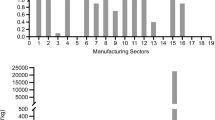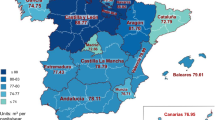Abstract
This paper investigated the relationships between industrial water use, income, trade, and employment for 17 Taiwanese industries from 1998 to 2015. We explored cross-sectional dependent unit root, panel cointegration, and causality tests to estimate their long-term relationships and causal nexus. There existed long-term equilibrium relationships among the variables. The long-term elasticity estimates of industrial water use with respect to income, squared income, trade, and employment are 4.27, − 0.15, 0.22, and 0.92, respectively. The results do not confirm an inverted U-shaped environmental Kuznets curve. A unidirectional causal relationship is found between water use and income, and a bidirectional causal relationship is identified between water use and employment. Exports cause industrial water use. As expected, both employment and exports lead to income. Hence, policy makers should promote investment into water efficiency and water recycling. Various governments reward firms for water efficiency and lower consumption without negative long-term effects on economic growth.


Similar content being viewed by others
Notes
Heckscher-Olin factor endowment theory provides an explanation of trade based on the differences in relative factor endowments. A country or region that is well endowed with labor is expected to produce labor-intensive goods in exchange for capital-intensive goods.
References
Akbostancı E, Turut-Asık S, Tunç G (2009) The relationship between income and environment in Turkey: is there an environmental Kuznets curve? Energ Policy 37:861–867
Al-Mulali U, Weng-Wai C, Sheau-Ting L, Mohammed AH (2015) Investigating the environmental Kuznets curve (EKC) hypothesis by utilizing the ecological footprint as an indicator of environmental degradation. Ecol Indic 48:315–323
Apergis N, Payne JE (2010) Energy consumption and growth in South America: evidence from a panel error correction model. Energy Econ 32:1421–1426
Bhattarai M (2004) Irrigation Kuznets curve governance and dynamics of irrigation development: a global cross-country analysis from 1972 to 1991. International Water Management Institute, Colombo
Bilgili F, Kocak E, Bulut U (2016) The dynamic impact of renewable energy consumption on CO2 emissions: a revisited environmental Kuznets curve approach. Renew Sust Energ Rev 54:838–845
Born B, Breitung J (2016) Testing for serial correlation in fixed-effects panel data models. Econ Rev 35(7):1290–1316
Breusch TS, Pagan A (1980) The Lagrange multiplier test and its applications to model specification in econometrics. Rev Econ Stud 47(1):239–253
Chen CZ, Chen GQ (2013) Virtual water accounting for the globalized world economy: national water footprint and international virtual water trade. Ecol Indic 28:142–149
Cole MA (2004) Economic growth and water use. Appl Econ Lett 111:1–4
Culas RJ (2007) Deforestation and the environmental Kuznets curve: An institutional perspective. Ecol Econ 61(2-3):429–437
Davijani MH, Banihabib ME, Anvar AN, Hashemi SR (2016) Optimization model for the allocation of water resources based on the maximization of employment in the agriculture and industry sectors. J Hydrol 533:430–438
Destek MA (2016) Renewable energy consumption and economic growth in newly industrialized countries: Evidence from asymmetric causality test. Renew Energy 95(C):478–484
Dinda S (2004) Environmental Kuznets curve hypothesis: a survey. Ecol Econ 49:431–455
Dogan E, Seker F (2016) Determinants of CO2 emissions in the European Union: the role of renewable and non-renewable energy. Renew Energy 94:429–439
Duarte R, Pinilla V, Serrano A (2013) Is there an environmental Kuznets curve for water use? A panel smooth transition regression approach. Econ Model 31:518–527
Dumitrescu EI, Hurlin C (2012) Testing for Granger non-causality in heterogeneous panels. Econ Model 29(4):1450–1460
Dutta R (2014) Climate change and its impact on tea in Northeast India. J Water Clim Change 5(4):625–632
Eberhardt M (2012) Estimating panel time series models with heterogeneous slopes. Stata J 12:61–71
Garrido A, Llamas R, Varela-Ortega C, Novo P, Rodríguez-Casado R, Aldaya MM (2010) Water footprint and virtual water trade in Spain. Policy implications Ed. Springer, New York
Gassebner M, Lamla, MJ, Sturm J.-E. (2006) Economic, demographic and political determinants of pollution reassessed: a sensitivity analysis. KOF Working Papers 129 KOF Swiss Economic Institute, ETH Zurich
Gu A, Zhang Y, Pan B (2017) Relationship between industrial water use and economic growth in China: insights from an environmental Kuznets curve. Water 9:556. https://doi.org/10.3390/w9080556
Gujarati DN (2003) Basic econometrics, 5th edn. McGraw-Hill, New York
He J, Richard P (2010) Environmental Kuznets curve for CO2 in Canada. Ecol Econ 69:1083–1093
Hemati A, Mehrara M, Sayehmiri A (2011) New vision on the relationship between income and water withdrawal in industry sector. Nat Resour 2(3):191–196
Hoekstra AY (2003) Virtual water trade: proceedings of the International Expert Meeting on Virtual Water Trade; Value of Water Research Report Series No.12; UNESCO-IHE: Delft, The Netherlands
Hoekstra AY, Hung PQ (2005) Globalization of water resources: international virtual water flows in relation to crop trade. Glob Environ Chang 15:45–56
Hoekstra AY, Mekonnen MM (2012) The water footprint of humanity. Proc Natl Acad Sci 109:3232–3237
Hong NB, Yabe M (2016) Improvement in irrigation water use efficiency: a strategy for climate change adaptation and sustainable development of Vietnamese tea production. Environ Dev Sustain 19(4):1247–1263
Horbach J (2010) The impact of innovations activities on employment in the environmental sector—empirical results for Germany at the firm level. J Econ Stat 230(4):403–419
Horbach J, Rennings K (2013) Environmental innovation and employment dynamics in different technology fields—an analysis based on the German Community Innovation Survey 2009. J Clean Prod 57(15):158–165
Jebli MB, Youssef SB, Apergis N (2015) The dynamic interaction between combustible renewable and waste consumption and international tourism: the case of Tunisia. Environ Sci Pollut Res 22(16):12050–12061
Jia S, Yang H, Zhang S, Wang L, Xia J (2006) Industrial water use Kuznets curve: evidence from industrial countries and implications for developing countries. J Water Resour Plan Manag 132(3):183–191
Kais S, Sami H (2016) An econometric study of the impact of economic growth and energy use on carbon emissions: Panel data evidence from fifty eight countries. Renew Sustain Energy Rev 59:1101–1110
Katz D (2015) Water use and economic growth: reconsidering the environmental Kuznets curve relationship. J Clean Prod 88:205–213
Kyophilavong P, Shahbaz M, Anwar S, Masood S (2015) The energy-growth nexus in Thailand: does trade openness boost up energy consumption? Renew Sust Energ Rev 46:265–274
Lean HH, Smyth R (2010) CO emissions, electricity consumption, and output in ASEAN. Appl Energy 87(6):1858–1864
Lee CC, Chiu YB, Sun CH (2010) The environmental Kuznets curve hypothesis for water pollution: do regions matter? Energ Policy 38:12–23
Linares P, Labandeira X (2010) Energy efficiency: economics and policy. J Econ Surv 24(3):573–592
Lu WC (2016) Electricity consumption and economic growth: evidence from 17 Taiwanese industries. Sustainability 9(1):1–15
Lu WC (2017) Renewable energy, carbon emissions, and economic growth in 24 Asian countries: evidence from panel cointegration analysis. Environ Sci Pollut Res 24(33):26006–26015
Mekonnen MM, Hoekstra AY (2014) Water conservation through trade: the case of Kenya. Water Int 39(4):451–468
Mekonnen MM, Hoekstra AY (2016) Four billion people facing severe water scarcity. Sci Adv 2(2):e1500323. https://doi.org/10.1126/sciadv.1500323
Miglietta PP, De Leo F, Toma P (2017) Environment Kuznets curve and the water footprint: an empirical analysis. Water Environ J 31:20–30
Molden D, Oweis T, Steduto P, Bindraban P, Hanjra MA, Kijne J (2010) Improving agricultural water productivity: between optimism and caution. Agric Water Manag 97(4):528–535
Omri A, Nguyen DK, Rault C (2014) Causal interactions between CO2 emissions, FDI, and economic growth: Evidence from dynamic simultaneous-equation models. Econ Model 42:382–389
Peng H, Tan X, Li Y, Hu L (2016) Economic growth, foreign direct investment and CO2 emissions in China: a panel Granger causality analysis. Sustainability 8(3):233. https://doi.org/10.3390/su8030233
Pesaran MH (2004) General diagnostic tests for cross section dependence in panels. Cambridge Working Papers 517in Economics No. 0435, Faculty of Economics, University of Cambridge
Pesaran MH (2006) Estimation and inference in large heterogeneous panels with a multifactor error structure. Econometrica 74(4):967–1012
Pesaran MH (2007) A simple panel unit root test in the presence of cross-section dependence. J Appl Econ 22(2):265–312
Pfeiffer F, Rennings K (2001) Employment impacts of cleaner production—evidence from a German study using case studies and surveys. Bus Strateg Environ 10(3):161–175
Phillips PCB, Sul D (2003) Dynamic panel estimation and homogeneity testing under cross section dependence. Econ J 6:217–259
Sardorsky P (2012) Energy consumption, output and trade in South America. Energy Econ 34(C):476–488
Shakeel M, Iqbal MM, Majeed MT (2014) Energy consumption, trade, and GDP: a case study of South Asian countries. Pak Dev Re 53(4):461–476
Sohag K, Begum RA, Abdullah SMS, Jaafar M (2015) Dynamics of energy use, technology innovation, economic growth and trade openness in Malaysia. Energy 90:1497–1507
Sonnenberg A, Chapagain A, Geiger M, August D (2009) The water footprint of Germany—where does the water incorporated in our food come from? WWF Germany, Frankfurt am Main
Sun S, Fang C (2018) Water use trend analysis: a non-parametric method for the environmental Kuznets curve detection. J Clean Prod 172:497–507
UN WATER REPORT (2016) Water and jobs facts and figures, The United Nations world water development report 2016
Van Halsema GE, Vincent L (2012) Efficiency and productivity terms for water management: a matter of contextual relativism versus general absolutism. Agric Water Manag 108(C):9–15
Vollebergh HRJ, Bertrand M, Elbert D (2009) Identifying reduced-form relations with panel data: The case of pollution and income. J Environ Econ Manag 58(1):27–42
Waluyo EA, Terawaki T (2016) Environmental Kuznets Curve for Deforestation in Indonesia: An ARDL Bounds Testing Approach. J Econ Coop Dev 37(3):87–108
Westerlund J (2007) Test for error correction in panel data. Oxf Bull Econ Stat 69:709–748
WWDR (2009) The UN World Water Development Report, 3rd report: Water in a changing world. UNESCO, Paris. http://www.unesco.org/water/wwap/wwdr/wwdr3. Accessed 20 Feb 2017
Zhang Y, Zhang J, Tang G, Chen M, Wang L (2016) Virtual water flows in the international trade of agricultural products of China. Sci Total Environ 557–558:1–11
Zhang C, Wang Y, Song X, Kubota J, He Y, Tojo J, Zhu X (2017) An integrated specification for the nexus of water pollution and economic growth in China: panel cointegration, long-run causality and environmental Kuznets curve. Sci Total Environ 609:319–328
Author information
Authors and Affiliations
Corresponding author
Additional information
Responsible editor: Philippe Garrigues
Rights and permissions
About this article
Cite this article
Lu, WC. Industrial water use, income, trade, and employment: environmental Kuznets curve evidence from 17 Taiwanese manufacturing industries. Environ Sci Pollut Res 25, 26903–26915 (2018). https://doi.org/10.1007/s11356-018-2726-3
Received:
Accepted:
Published:
Issue Date:
DOI: https://doi.org/10.1007/s11356-018-2726-3




